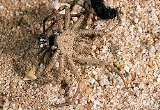
Six-eyed sand spider
Encyclopedia
The six-eyed sand spider (Sicarius hahni) is a medium-sized spider
with body measuring 8 to 15 mm and legs spanning up to 50 mm, found in deserts and other sandy places in southern Africa
. It is a member of the Sicariidae
family; close relatives may be found in both Africa and in South America
, and its near cousins, the recluses
(Loxosceles), are found worldwide. Due to its flattened stance and laterigrade legs, it is also sometimes known as the six-eyed crab spider. Bites by Sicarius to humans are uncommon; there are no proven cases and only two suspected cases where the culprit was never identified. Sicarius bites have been experimentally shown as lethal to rabbits within 5 to 12 hours. The genus name Sicarius is Latin for 'murderer', from sica, a curved dagger. The species was described by Carl Wilhelm Hahn
.
at prey that wanders too closely. Sand particles adhere to cuticles on its abdomen, thus acting as a natural camouflage if uncovered. If disturbed, it will run a short distance and bury itself again.
/necrotoxic effect, causing blood vessel leakage, thinning of the blood and tissue destruction. Sicarius bite treatment should be directed, as with all cytotoxic bites, at prevention of secondary infection and combating Disseminated intravascular coagulation
(DIC) if it develops. No anti-venom exists for it. However, there has only been one confirmed death from it.
Spider
Spiders are air-breathing arthropods that have eight legs, and chelicerae with fangs that inject venom. They are the largest order of arachnids and rank seventh in total species diversity among all other groups of organisms...
with body measuring 8 to 15 mm and legs spanning up to 50 mm, found in deserts and other sandy places in southern Africa
Africa
Africa is the world's second largest and second most populous continent, after Asia. At about 30.2 million km² including adjacent islands, it covers 6% of the Earth's total surface area and 20.4% of the total land area...
. It is a member of the Sicariidae
Sicariidae
Sicariidae is a family of six-eyed venomous spiders known for their necrotic bites. The members of this family are haplogyne by definition . The family consists of two genera, Loxosceles and Sicarius, and contains about 120 species...
family; close relatives may be found in both Africa and in South America
South America
South America is a continent situated in the Western Hemisphere, mostly in the Southern Hemisphere, with a relatively small portion in the Northern Hemisphere. The continent is also considered a subcontinent of the Americas. It is bordered on the west by the Pacific Ocean and on the north and east...
, and its near cousins, the recluses
Brown recluse spider
The brown recluse spider or violin spider, Loxosceles reclusa, is a member of the family Sicariidae . The spider has a venomous bite....
(Loxosceles), are found worldwide. Due to its flattened stance and laterigrade legs, it is also sometimes known as the six-eyed crab spider. Bites by Sicarius to humans are uncommon; there are no proven cases and only two suspected cases where the culprit was never identified. Sicarius bites have been experimentally shown as lethal to rabbits within 5 to 12 hours. The genus name Sicarius is Latin for 'murderer', from sica, a curved dagger. The species was described by Carl Wilhelm Hahn
Carl Wilhelm Hahn
Dr. Carl Wilhelm Hahn was a German zoologist and author of the first German monograph on spiders. C. W. Hahn was an all-round natural scientist – not at all unusual for his time. Surprisingly he seems to have been almost forgotten...
.
Behavior
This spider buries itself in the sand and strikes from ambushAmbush predator
Ambush predators or sit-and-wait predators are carnivorous animals that capture prey by stealth or cunning, not by speed or necessarily by strength. These organisms usually hide motionless and wait for prey to come within striking distance. They are often camouflaged, and may be solitary...
at prey that wanders too closely. Sand particles adhere to cuticles on its abdomen, thus acting as a natural camouflage if uncovered. If disturbed, it will run a short distance and bury itself again.
Venom
Toxicology studies have demonstrated that the venom is particularly potent, with a powerful hemolyticHemolysis
Hemolysis —from the Greek meaning "blood" and meaning a "loosing", "setting free" or "releasing"—is the rupturing of erythrocytes and the release of their contents into surrounding fluid...
/necrotoxic effect, causing blood vessel leakage, thinning of the blood and tissue destruction. Sicarius bite treatment should be directed, as with all cytotoxic bites, at prevention of secondary infection and combating Disseminated intravascular coagulation
Disseminated intravascular coagulation
Disseminated intravascular coagulation , also known as disseminated intravascular coagulopathy or consumptive coagulopathy, is a pathological activation of coagulation mechanisms that happens in response to a variety of diseases. DIC leads to the formation of small blood clots inside the blood...
(DIC) if it develops. No anti-venom exists for it. However, there has only been one confirmed death from it.

